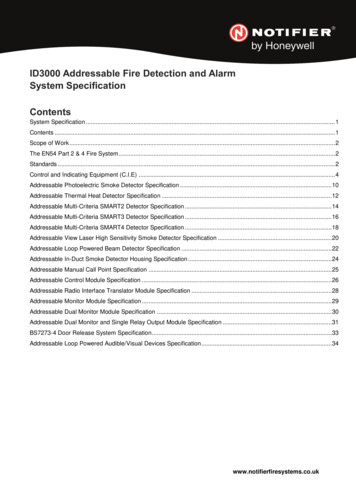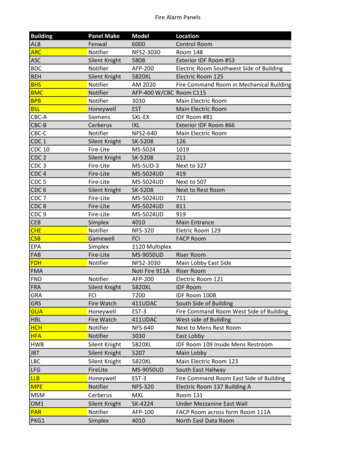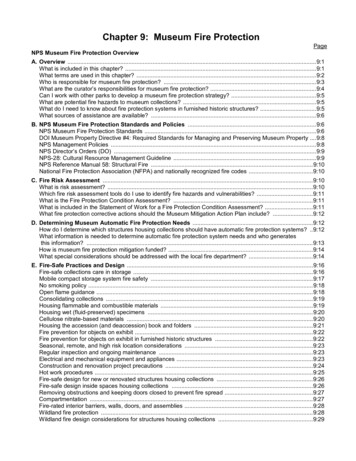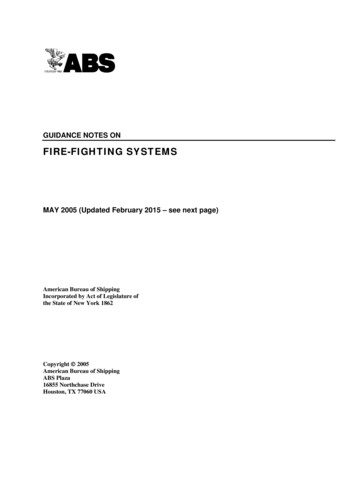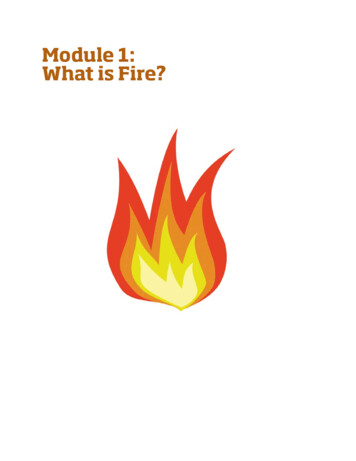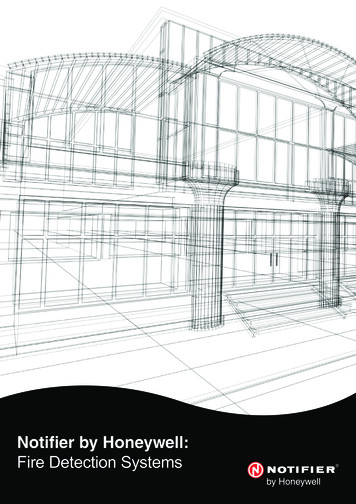
Transcription
Fire Detection Systems
Fire detection systems8/8/0611:46Page 3contentsconventional fire alarm systems4intelligent fire alarm systems9detector application guide15
Fire detection systems8/8/0611:46Page 4conventional firealarm systemsA conventional fire alarm systemnormally consists of a control panellinked to a number of lines of firedetectors and manual call points,normally called detection zones,and a number of sounder or alarmcircuits. A simple system is shownin Figure 1.FIREALARMCONTROLPANELFIREALARMCIRCUITcontrol panelThe control panel drives thedetection zones and soundercircuits, provides LED indicationsof fire, fault or normal conditionsand contains switches to allow thesounders to be activated or silencedand the detectors to reset followingan alarm. The control panel ispowered from the mains (230VAC)and will contain back-up batteriesto allow the system to function forEOLprincipleof operationa minimum of 24 hours, dependanton the application, in case of amains failure.System OKZone 1 AlarmZone 2 AlarmAlarm Cct FaultFIREDETECTIONZONE 1System ResetFIREDETECTIONZONE 2Figure 1: Simple conventional fire alarm system4EOLZone 2 FaultEOLZone 1 FaultNote: There are numerous suppliersof fire control equipment and firedetection devices. There is noguarantee that all panels and alldetectors are electricallycompatible. Therefore, to avoidpotential incompatibility issues, it isstrongly recommended to purchaseboth groups of products from thesame source, or to obtainconfirmation of compatibility fromthe panel manufacturer.fire detectionand alarmzonesMost conventional fire alarm panelshave several detection zonescomprising a mixture of automaticfire detectors and manual callpoints. In order to limit the effect offaults, and to limit the search area inthe case of a fire, the size of a firedetection zone is limited to 2000m2,with a maximum travel distancewithin the zone to locate a fire of60m. In addition, zones should notcover more than one storey, unlessthe total floor area of the building isless than 300m2. As a result unlessthe site is very small, the system willcomprise several detection zones.A fire alarm (or sounder) circuit maycover more than one detectionzone, but it must follow theboundaries of the relevant detectionzones, and the boundaries shouldbe of fire resisting construction.
8/8/0611:46Page 5conventionalsystemoperationdetection line operationConventional detection systemsnormally operate on a 24VDC line.In the standby condition, thedetectors will draw a low current,typically less than 100μA. When thedetector senses a fire, it will switchinto the alarm condition with it'sLED illuminated, and will collapsethe line voltage by drawing a largercurrent - dependant on thedetectors and control panel, buttypically 50-80mA. The controlpanel can sense this, and activatethe appropriate alarms. Thedetector will remain latched in thealarm state with its LEDsilluminated, even if the smoke orheat is removed until it has beenreset from the panel by momentarilyremoving power from the line.This allows the fire to be locatedeven if the signal is intermittent, orto locate possible sources ofnuisance alarms.For some control panel - detectorcombinations, when a standardbase is used, there is anincompatibility between the currentspecifications of the detector andpanel, leading to incorrect reportingby the control panel, for examplesignalling a fault in place of analarm, and in some cases damageto the detector due to over currentin the alarm state. In these cases itis necessary to use a base fittedwith a resistor in series with thedetector to limit the current drawin alarm. Resistors fitted into thedetector base are also used insome cases to distinguish betweena short circuit fault and an alarm.The value of the base resistor isdependant on the control panel,however a typical value is 470Ohms. If in any doubt, contact thecontrol panel manufacturer whoshould be able to specify whichdetector bases should be usedwith different detector brands.detection linefault monitoringA manual call-point consists of asimple switch with a resistor inseries with it, usually 470 Ohms or680 Ohms. When the call point isactivated, the resistor is switchedacross the line, and a current of50-80mA, dependant on thecontrol panel, is drawn.In order to detect an open circuit, ordetector head removal, a device isconnected across the end of thezone, which can be monitored.This device can take various formsdependant on the control panel.Standard conventional systems areable to monitor the zone for shortcircuit, open circuit and detectorhead removal.When a short circuit occurs on azone, a high current will be drawn,and the line voltage will be pulledtowards zero volts. The paneldetects the low voltage / highcurrent and a fault is signalled. 24VContact Closedwhen detectorinserted in baseResistorFire detection systems0VFigure 2: Resistive end of line operation5
Fire detection systems8/8/0611:46The simplest end of line device isa resistor, which will draw a currentdistinct from the quiescent andalarm currents drawn by thedetectors. Installation of detectorsinto their bases closes a contact inthe base supplying the remainder ofthe zone. Thus if the line is broken,or if a detector head is removed,the current drawn by the zone willfall, and a fault will be signalled(See figure 2). Example zone currentand voltage figures aregiven in figure 3.Page 6removed detector, it will no longerwork, which contravenes therequirements of BS5839 part 1. Toovercome this either all call pointsmust be mounted at the start ofeach zone, or in completelyseparate zones (both of thesesolutions are often impractical andtoo costly), or head removalmonitoring can be employed.Active monitoring uses bases fittedwith a diode across the contact inthe base (fig 4). Whilst the detectorMonitoring of detection line(example only)ConditionCurrentVoltageOpen Circuit 3mA24VNormal5mA (dependant on EOL device)18VFire50mA (dependant on control panel)4 –15VShort CircuitHigh (dependant on control panel)0VFigure 3: Example resistive conventional system current and voltage figuresThe problem with a simple resistiveend of line is that should a detectorhead be removed, the remainder ofthe zone beyond that detector islost and no alarm can be signalledbeyond this point. Should a callpoint be mounted beyond theis mounted in the base, the basecontact connects directly across thediode, and links it out. There isusually provision for manuallylinking the diode out to permitcontinuity testing duringcommissioning. When the detectorE.O.L. 24V0VContact Closeswhen detectorinserted in baseFigure 4: Active end of line monitoring circuit6head is removed, the diode isconnected across the contact,allowing power to continue to besupplied to the remainder of thezone, whilst still permitting theremoved detector to be monitored.This is achieved in a numberof ways.An active end of line device uses aswitched resistor at the end of lineand can thus be used with astandard control panel. It sends aperiodic signal back along thedetection line, which is normallyquenched by the control panel.When a head is removed, the basediode is switched into the line, andpulse can be seen. The Active endof line then switches the resistor outof the line, and a fault is signalled.If a capacitive end of line is used,the panel periodically drops the linevoltage for a few milliseconds, andlooks for the line voltage being heldup by the capacitor. When a head isremoved, the panel will see the linevoltage drop immediately as thecapacitor's discharge will beinhibited by the diode, and therebya fault can be signalled.A third type of end of line device isa diode. With this the panelperiodically reverses the line voltagefor a few milliseconds: If the line isbroken by the diode in the detectorbase, then no current can flow inthe reverse direction.The type of end of line monitoringused on a system will dependon the control panel. However itis important, particularly whenusing active end of line monitoring
Page 7wires, see figure 5. In this instance,a base incorporating a change overrelay is used. This configuration isknown as a four-wire system, and isoften seen when a fire zone isintegrated into a security panel.Normally after an alarm, thedetectors are reset by disconnectingthe power to the relevant zone for ashort period by pressing a centralpanel reset button. Fire panels havethis facility built in, however manysecurity panels are unable to do thiswithout turning the entire panel off.Therefore to allow the use of- 24VDCPOWER SUPPLYEND OF LINERELAY COIL- 24VDC IN 24VDC OUT 24VDC IN- 24VDC OUTALARMRELAY (N/O)BEAM DETECTOR #2MAINTENANCERELAY (N/C)BEAM DETECTOR #1FAULTRELAY (N/C)- 24VDC IN 24VDC 24VDC OUTMost system smoke detectors areequipped with a terminal to allowthe connection of a remote LED.Remote LEDs are often usedoutside bedroom doors in hotels sothat in case of a fire, it is easy forthe fire brigade to identify thelocation of the fire without needingto enter every room in the building.They may also be used where adetector is located in a hiddenposition, such as a floor or roof voidor cable tunnel, for example, toprovide a visual indication that thedetector is in an alarm state.Figure 5 shows the simplest form offour-wire system, as used with mostsecurity panels. This is used wherethe monitor line is able only toregister an open or closed circuit there is no distinction between afault and a fire. By using a normallyclosed relay at the end of the powerline, it is possible to monitor for apower failure to the detectors. Therelay contacts are wired in serieswith the normally closed contacts ofthe detector relay base(s). Thus inthe normal state the detectioncircuit is closed; in the case of fireor power failure the relevant relaycontacts will open.ALARMRELAY (N/O)remote LEDs 24VDC INto ensure that the detectorsare compatible with the typeof monitoring being used.Reference must be made tothe panel manufacturer toensure compatibility.- 24VDC OUT11:46FAULTRELAY (N/C)8/8/06MAINTENANCERELAY (N/C)Fire detection systemsEOLDETECTION CIRCUITResistorIn some cases it is necessary thatthe power to the detectors and thefire detection signal be on separateResistorfour-wire system operationFigure 6: 4-wire system with full monitoringDetection Line(Open Circuit forAlarm and Fault)FIREALARMCONTROLPANELPower Supply(Nominal 12Vor 24V System)End of LineMonitoring RelayC NO NCFigure 5: Typical 4 wire system wiringC NO NCdetectors with security panels,non-latching versions of the relaybases are usually made available,which automatically isolate thedetector from the supply every fewseconds. Thus once the firecondition has passed the detectorwill automatically reset (note thatthe alarm condition should belatched at the control panel.)Four-wire type systems are alsooften used with devices such asbeam detectors where an auxiliary7
Fire detection systems8/8/0611:46power supply may be required. Inthis case if the device is connectedto a fire control panel, able todistinguish between differentdetector states, the circuit can berouted to provide full monitoring foralarm and fault. Figure 6 showstypical wiring for a beam detector,which includes it's own internalmaintenance and fault monitoring.With this layout all fault andmaintenance contacts are wired inseries, and all alarm contacts inparallel with the end of line device.In the case of a fault ormaintenance signal, the end of linewill be disconnected, and a faultcan be signalled at the panel. Todistinguish between an alarm andshort circuit, a resistor, typicallyPage 8470 Ohms is placed in series witheach alarm contact as indicated inorder to shunt the detector zone.Note that a separate reset signalmay be required to reset somebeam detectorsfire alarm (sounder)zone operationSimilarly to detection lines, it isimportant to monitor fire alarmzones to ensure that the cable hasnot been broken, disconnected orshorted. However the operation ofalarm zones is different fromdetection lines.Fire alarm sounders contain apolarising diode, which allows themto operate when a voltage is appliedin one direction, but not when thevoltage is reversed. When thesystem is in standby, the panelapplies a voltage in the 'wrong'direction, so that the sounders donot operate and do not draw anycurrent. An end-of-line resistordraws a constant monitoringcurrent, which allows the panel toverify that the wiring is intact.Should the panel sense that nocurrent is being drawn, it signals anopen circuit fault. In the case of ashort circuit, a high current is drawnfrom the zone, the voltage dropstowards zero and a fault conditionis shown. To activate the sounders,the control panel reverses thepolarity of the voltage to the zone.Alarm24VDCFigure 7: Conventional fire alarm sounder circuit8EOLStandby24VDC
Fire detection systems8/8/0611:47Page 9intelligent firealarm systemsintroductionConventional fire alarm systemsprovide an adequate and costeffective fire alarm system for manysmall buildings. In larger, morecomplex buildings however, moresophisticated ‘intelligent’ fire alarmsystems tend to be used. Thesesystems offer benefits in speed ofdetection, identification of thelocation of a fire and easiermaintenance. Intelligent systemsalso offer tolerance to faults in thesystem wiring, which allows a singlepair of wires to be used to connecta large number of devices to thesystem, allowing cost savings in thewiring of large systems. In largerinstallations, the benefits ofimproved maintenance and reducedcabling cost are overwhelming.Currently, the point at which anintelligent system becomeseconomical is around 6 zonesin the UK.This guide is intended as anintroduction to the technology usedin intelligent fire alarm systems.FIRE ALARM SYSTEM OK28 January 200414:01SYSTEM OKFIRE ALARMFAULTEOLCONTROLMODULECONVENTIONALALARM ZONEINTELLIGENTFIRE .G. SPRINKLERSWITCHISOLATORFigure 8: Intelligent fire alarm systemsThe control panel communicateswith each device on the loop, and ifan alarm or fault condition issignalled, or if communications arelost with one or more detectors, theappropriate response is triggered.The loop can be powered from eachend so that if the loop is broken atany point, no devices are lost. Inaddition the use of short circuitisolators minimises the area ofcoverage lost in the case of ashort circuit.intelligentsystem typesISOLATORSYSTEM RESETFigure 8 demonstrates an exampleof a single loop intelligent firesystem layout. The wiring is looped,and connects to the control panel ateach end. All detectors, call points,sounders and interface modules arewired directly to the loop, eachhaving its own address.There are two methods commonlyused for implementing intelligentfire systems:The most common type of system is“Analogue”. In this case the detector(or sensor) returns a value to thepanel representing the current stateof its sensing element(s).The control panel compares thisvalue with the alarm threshold inorder to make the decision as towhether a fire is present. Note thatthe term analogue, used to describethese systems does not refer to thecommunication method (indeedmany “analogue” fire systems use9
8/8/0611:47Page 10digital communications) but to thevariable nature of the response fromthe detector to the control panel.In “Addressable” type intelligentsystems, mainly used to meet therequirements of the French market,detector sensitivity is programmedto each device by the control panelor is preset in the factory.The detector compares its currentsensor value with the configuredthreshold to make the alarmdecision, which is then transmittedto the panel when the sensor isinterrogated.In many systems the featuresoffered by the two detectiontechniques are so similar that it isnot particularly relevant whichtechnique is used to make the alarmdecision. It is better to select asystem based on the featuresoffered by the system as a whole.A typical basic protocol comprisestwo main parts (See Fig 9): A queryor poll of a device by the controlpanel including the device addressand control information, and aresponse from the device giving itsstatus and other information.Precise details of the informationtransferred will depend on themanufacturer, but normally willinclude: Status of module outputPoll: Control Panel to device: Device address Control of device LED blink to indicate polling,switch on when device isin alarm Control of device self-test Error detection forexample parity bit orchecksumIntelligent systems use the samepair of wires both to supply powerto the loop, and to communicatewith devices on the loop.Response: Device toControl Panel Device type (e.g. opticaldetector, heat detector,multi-sensor detector,module)The communication language, orprotocol used varies fromPanel to detectorControlFigure 9: Typical protocol configuration Alarm Signal ifappropriate Remote test status Manufacturer codeMost commonly, each device on theloop will be polled in turn, howeverto increase speed around a loop,some protocols allow polling ofgroups of devices on a singlecommunication.Note that since differentmanufacturers have their ownprotocols, it is important toensure compatibility between thedetectors and control panel youintend to use. Some detectormanufacturers produce intelligentdetectors with differentcommunication protocols fordifferent customers, so twodetectors which look virtuallyidentical in appearance may notbe compatible. Always checkwith the manufacturer of thecontrol panel.addressingmethodsDifferent manufacturers of intelligentsystems use a number of differentmethods of setting the address ofa device, including:Detector ResponseError CheckDetectorAddress10 Analogue Signal - i.e. thecurrent sensor value Control of module outputcommunicationprotocol 24Vmanufacturer to manufacturer, butgenerally comprises switching of the24V supply voltage to other voltagelevels to achieve communication.DeviceTypeTest StatusFire detection systemsSensorValueOther Infoe.g. driftstatus3214 509TENS6783214 509678UNITSFigure 10: Decade address switchesaddress 03 selected
Fire detection systems8/8/0611:47Page 11 7-bit binary orhexadecimal DIL switch Dedicated addressprogrammer Automatic, according tophysical position on theloop Binary ‘address card’fitted in the detector base Decimal address switchesUsing the Decimal Address Methoddifferences in the protocol betweendetectors and modules allow themto have the same address withoutinterfering with each other, andnormally address 00 (the factorydefault setting) is not used withina system so that the panel canidentify if a device address has notbeen set: Hence a total of up to198 devices - 99 detectors and 99modules (including call points,sounders, input and outputmodules) may be connected toa loop.system faulttoleranceDue to the looped wiring methodused for analogue systems, they aremore tolerant to open and shortcircuit wiring faults thanconventional systems.Under normal conditions, the loopwill typically be driven only from oneend. If the loop is broken (See figure11.), the panel will detect the loss ofcommunications with the detectorsbeyond the break, signal a fault, andswitch to drive the loop from bothends. The system therefore remainsfully operational, and can possiblyeven indicate the area of the break.In order to give tolerance againstshort circuits on the loop, shortcircuit isolators are placed atintervals on the loop. Should a shortcircuit occur on the loop (Figure 12)the isolators directly on either sideof the fault will isolate that section.The panel will detect the loss of thedevices, signal a fault and drive theloop from both ends, therebyenabling the remainder of the loopto operate correctly and ensuringminimum loss of coverage.Short circuit isolators are availableas separate modules andincorporated into a detector base.Some products have isolators builtinto each of the loop devices. Withthis configuration, since only thesection of wiring between the twoadjacent devices is isolated therewill be no loss of coverage shoulda short circuit occur.IsolatingImpedance24VSYSTEM FAULT: OPEN CIRCUIT:Zone 2 Module 01FIRST FLOOR CANTEENSYSTEM OKFIRE ALARMFAULTSYSTEM RESETINTELLIGENTFIRE ALARMCONTROL PANELLine breakPanel detects the loss ofdevices after the break,signals a fault and powersfrom both ends of the loopto retain full coverage.Isolators on either side ofthe short circuit switch animpedance onto the lineto isolate it.24VSYSTEM FAULT: SHORT CIRCUIT:Zone 2 DETECTOR 03FIRST FLOOR CANTEENSYSTEM OKFIRE ALARMFAULTSYSTEM RESETShort CircuitINTELLIGENTFIRE ALARMCONTROLPANEL 24VDevices between the twoisolators are lost,however the remainder ofthe circuit still operatescorrectly.Isolators automaticallyreset the line when theshort circuit is removed24VIsolatingImpedanceFigure 11: Open circuit faultFigure 12: Short circuit fault11
Fire detection systems8/8/0611:47Page 12driftcompensationandmaintenancealarma “drift compensation” function,included in either the detector or thecontrol panel algorithms. Thesefunctions use algorithms thatmonitor the sensitivity of a detector,and modify its response tocompensate for a build up of dust inthe chamber over time. Once thedetector reaches the “drift limit”when the dirt build up can no longerbe compensated for, a fault can besignalled. Some systems alsoincorporate a warning to signalthat a detector is approachingits compensation limit andrequires cleaning.The sensitivity of a smoke detectortends to change as it becomescontaminated with dirt or dust (seefigure 13). As contamination buildsup, it usually becomes moresensitive, leading to the risk of afalse alarm, but in some cases canChamber ValueThresholdincreased tocompensate forincreased chamberclean air value.Smoke required toreach alarmthreshold reduces Detector sensitivityincreasesTimeClean AirValueUncompensatedAlarm ThresholdUncompensatedChamber ValueCompensatedThresholdFigure 13: Chamber contamination and drift compensationbecome less sensitive, so delayingthe alarm if a fire is detected. Tocounter this, if a detector driftsoutside its specification, amaintenance signal may be sent tothe panel warning that the detectorneeds cleaning.To further increase the maintenanceinterval, many systems incorporate12pre-alarmfacilityOne advantage of intelligent typesystems is that since the data sentby a detector to the panel varieswith the local environment, it can beused to detect when the device isapproaching an alarm condition.This “Pre-Alarm” can be signalledat the panel and can therefore beinvestigated to check if there is areal fire, or if it is caused by othersignals, for example steam or dustfrom building work. This can avoidthe inconvenience and expense ofevacuating a building or calling outthe fire brigade unnecessarilybecause of a nuisance alarm. ThePre-Alarm Threshold is typicallyset at 80% of the alarm threshold.fire alarmsWhen a fire is detected, the controlpanel indicates an alarm byactivating the fire indicator for therelevant zone on the control panel,sending a command to the relevantdetector to illuminate its LED andactivate alarm signals to startevacuation. Most intelligent firesystem control panels includealphanumeric displays enablingthem to show information on thesource of the alarm. This maysimply be a zone and detectoraddress, or could be moredescriptive for example “SmokeDetector, Bedroom 234”. Thecontrol panel may also use controlmodules to operate additionalelectrical equipment such as airconditioning units and doorreleases to prevent the spread ofsmoke and fire.The alarm signals can either be azone of conventional sounders andstrobes activated via controlmodules on the loop or directly fromthe control panel, or addressableloop powered devices connected onthe same loop as the detectors and
Fire detection systems8/8/0611:47Page 13activated by direct command fromthe panel. Loop powered sounderstend to have lower wiring costs,however the number permissibleon the loop may be restricted bycurrent limitations.On larger sites, it may be desirableto use zoned alarms. This allows aphased evacuation to be carriedout, with areas at most immediaterisk being evacuated first, then lessendangered areas later.fire systemzonesConventional fire alarm systemsgroup detectors into ‘zones’ forfaster location of a fire, with all thedetectors in a particular zone beingconnected on one circuit. Althoughintelligent systems allow the precisedevice that initiated an alarm to beidentified, zones are still used inorder to make programming thesystem and interpreting the locationof a fire easier. The control panelmay have individual fire indicatorsfor each zone on the system, andthe control panel response to analarm is often programmedaccording to the zone of thedevice in alarm rather than itsindividual address.The division of a loop into zones isachieved within the panel software,however, as multiple zones arephysically connected onto the samecable, a short circuit can affect theoperation of a large area ofdetection devices unlike aconventional system. BS5839 part 1therefore recommends the divisionof the loop as to limit the effect of ashort circuit with the use of shortcircuit isolators. The placement ofthese isolators should typically limitthe loss of coverage to less than2,000 m2 nor more than one floor(figure 14). Allowances are made forthe floor above and below but thisis limited as not to affect more thanfive devices on these floors.remote LED’sMost system smoke detectors areequipped with a terminal to allowthe connection of a remote LED.Remote LEDs are often used outsidebedroom doors in hotels so that incase of a fire, it is easy for the firebrigade to identify the location ofthe fire without the need to enterevery room in the building. Theymay also be used where a detectoris concealed in loft space, for example,to provide a visual indication thatthe detector is in an alarm state.interfacemodulesFigure 14: Intelligent system fire zonesInput and Output modules can beused to provide an interfacebetween a fire loop and a variety oftypes of electrical equipment.Output or control modules can beused to operate sounders or shutdown electrical equipment bycommand from the panel in case ofa fire. Input or monitor modules areused to monitor volt-free switchcontacts, for example from asprinkler supervisory switch or anexisting conventional fire panel.13
Fire detection systems8/8/0611:47Conventional zone monitor modulesare also available, providing aninterface between a zone ofconventional detectors and ananalogue fire detection loop, andare often used when existingconventional systems are upgraded.programmingof intelligentfire alarmpanelsMost small intelligent systems canbe programmed with ease withoutthe need for any specialisedequipment. The control panel has analphanumeric keypad, which is usedto enter data into the system.Typically a password is required toset the panel to ‘engineering mode’,allowing the panel to beprogrammed. Many control panelshave an ‘auto-learn’ facility,whereby the control panel pollsevery address on the system, anddetects which addresses have beenused, and what type of detector ormodule has been connected to eachaddress. As a default, the panel willusually programme all the deviceson the loop into the same zone.The user can then customise thesystem by entering how the zonesare configured. The panel may givethe user an option of how modulesare to be configured - for examplewhether an input module shouldtrigger an alarm or a fault whenoperated and whether the wiringis to be monitored for opencircuit faults.14Page 14Other optional features may also beprogrammed using the keypad. Thesensitivity of each detector on thesystem can be configured for highsensitivity if the detector is installedin a clean smoke-free area, or forlow sensitivity if the area is subjectto cigarette smoke, for example.Complex intelligent systems offermany user-programmable featuresthat can be time-consuming to entermanually using the keypad. In thiscase, many panels have the facilityto connect a portable PC by meansof a serial data link.The user is supplied with aspecialised piece of software, whichenables the entire configuration ofthe system to be programmed intothe PC, away from site if necessary.It is then a simple matter oftemporarily connecting the PC tothe control panel and downloadingthe system configuration to thepanel. Once the information hasbeen downloaded, it is permanentlystored in the control panel, and thePC can be removed.advantages ofintelligentsystems The wiring cost of asystem can be reduced bythe use of a single pair ofwires for many devicesincluding smoke and heatdetectors, call points,beam detectors, input andoutput modules. Intelligent Systems allowthe location of a fire to beprecisely located from thecontrol panel The use of looped wiringallows the system tofunction normally evenwith an open circuit in theloop wiring The use of short circuitisolators allows correctoperation of most, if notall of the system evenwith a short circuit in theloop wiring Detectors are constantlymonitored for correctoperation The use of a ‘pre-alarm’feature alerts staff tocheck whether a firecondition exists beforethe alarm is raised Different detectorsensitivities can be usedfor diverse applications The use of addressableloop-powered soundersallows the same wiring tobe used for sensors, callpoints and sounders The use of monitormodules allows contactsfrom sprinkler switches,existing fire alarmsystems, fire dampers etc.to be monitored usingdetector loop wiring The use of controlmodules allows sounderlines, air conditioningsystems, lifts etc. to becontrolled or shut downusing detector loop wiring
11:47Page 15detectorapplicationguidecategory L systemsCategory L systems are automaticfire detection systems intended toprotect life. The category is furthersubdivided as follows:system certain areas within abuilding, defined by the fire systemspecification, are protected byautomatic f
intelligent fire alarm systems conventional fire alarm systems detector application guide 4 9 15 Fire detection systems 8/8/06 11:46 Page 3. principle of operation A conventional fire alarm system normally consists of a control panel linked to a number of lines of fire detectors and manual call points,
